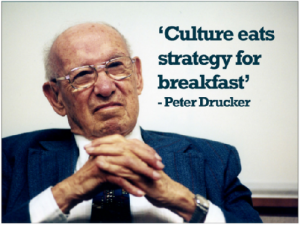There is a Peter Drucker quote making the rounds on LinkedIn, “Culture eats strategy for breakfast”. Ever wondered what it actually means? Well, there is a perfect example being played out right before our eyes right now: The difficulties of New York Times to succeed in the digital media landscape, as revealed by the innovation report that got “leaked” in the spring of 2014. It is a very powerful example of what happens when culture holds back a company from making necessary changes. Many people working at the New York Times have probably tried to bring change, only to see themselves beaten by unspoken rules and time-honored traditions. It’s likely a major reason why so many involved in digital developments have left the newspaper in recent years.
It is a very powerful example of what happens when culture holds back a company from making necessary changes. Many people working at the New York Times have probably tried to bring change, only to see themselves beaten by unspoken rules and time-honored traditions. It’s likely a major reason why so many involved in digital developments have left the newspaper in recent years.
The key point in the report, at least in this context, can be found in this quote: “At The Times, we generally like to let our work speak for itself. We’re not ones to brag. After we spent more than a year producing a signature piece of journalism — the “Invisible Child” series — we alerted our marketing and PR colleagues too late for them to do any promotion ahead of time. The reporter didn’t tweet about it for two days. ”
The company culture demanded that no promotion or advance notice was given to a piece, it would be published and then its value would be decided by the readership. But, as Paul Berry of Huffington Post says in the report, that’s not how things are done today:“At The New York Times, far too often for writers and editors the story is done when you hit publish. At Huffington Post, the article begins its life when you hit publish.”
Another way that culture beats strategy and attemps to modernize can be found in how the NY Times views its readership – waiting for them to publish the latest edition – and how that readership really behaves: “More readers expect us to find them on Twitter and Facebook, and through email and phone alerts. But the newsroom pays less attention to these platforms, even though they offer our main, and sometimes only, channels to tens of millions of readers.”
The Times is a world-class newspaper, but their own culture sets them up for failure by allowing competitors that understand the digital and social arena better to beat them at their own game: ”On Oscar night, The Times tweeted a 161-year-old story about Solomon Northup, whose memoir was the basis for “12 Years a Slave.” After it started going viral on social media, Gawker pounced, and quickly fashioned a story based on excerpts from our piece. It ended up being one of their best-read items of the year. But little of that traffic came to us.”
One final exampe of failure to adapt demonstrates how routines and processes, another favorite place for culture to play a strong part, causes a major problem: “At a time when nearly 60 percent of our readers access us via mobile devices, we are missing an opportunity to serve up content that’s relevant to their locations because we are not tagging stories with geographic coordinates.”
For anyone working with digital strategy this report is a must read. But it’s equally important for anyone working with strategy. Because there are a lot more companies caught in the same predicament as the NY Times than there are those that are successfully navigating the changes in how we do business.
So what can be done? The New York Times has already taken a major step through identifying these problems, and finding ways to change. Constantly questioning the way you do things in a company and why is one way to see if culture is keeping us from evolving and changing.
Another action is to look at what is happening within the industry as a whole – again a step the New York Times already has taken. The report states ”Because we are journalists, we tend to look at our competitors through the lens of content rather than strategy. But BuzzFeed, Huffington Post and USA Today are not succeeding simply because of lists, quizzes, celebrity photos and sports coverage. They are succeeding because of their sophisticated social, search and community-building tools and strategies, and often in spite of their content.” This is a situation many other companies are facing – it’s not just about having the best product anymore (if it ever was).
But the biggest step, and the most difficult one is to transform the company culture into something that will allow for change and transformation, not resist it. A strong culture is very important to all companies, and it can play a powerful role in helping the company develop, but only if willingness to change is included in the culture. Jim Collins and Jerry Porras said it best in Built to Last ”A visionary company carefully preserves and protects its core ideology, yet all the specific manifestations of its core ideology must be open for change and evolution”. A culture like that will not eat strategy for breakfast, it will join together with strategy to make a meal of the competition instead.
This post was originally published on LinkedIn in June, 2014
0 kommentarer på Culture eats strategy for breakfast, New York Times style